Peugeot 3008 Dag 2010.5 Owner's Manual
Manufacturer: PEUGEOT, Model Year: 2010.5, Model line: 3008 Dag, Model: Peugeot 3008 Dag 2010.5Pages: 324, PDF Size: 22.01 MB
Page 161 of 324
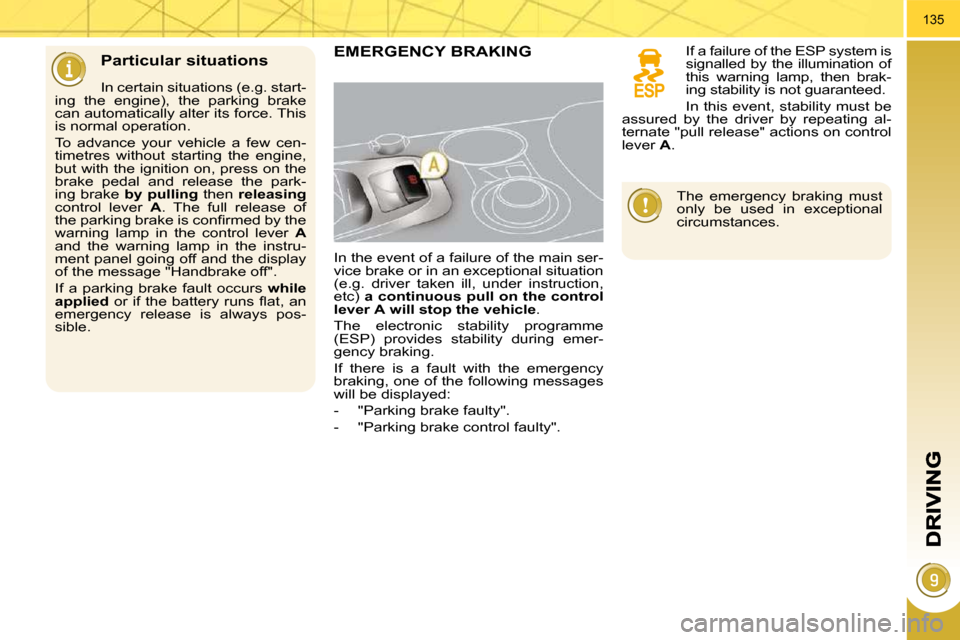
135
Particular situations
In certain situations (e.g. start-
ing the engine), the parking brake
can automatically alter its force. This
is normal operation.
To advance your vehicle a few cen-
timetres without starting the engine,
but with the ignition on, press on the
brake pedal and release the park-
ing brake by pulling then releasing
control lever A . The full release of
�t�h�e� �p�a�r�k�i�n�g� �b�r�a�k�e� �i�s� �c�o�n�fi� �r�m�e�d� �b�y� �t�h�e�
warning lamp in the control lever A
and the warning lamp in the instru-
ment panel going off and the display
of the message "Handbrake off".
If a parking brake fault occurs while
applied � � �o�r� �i�f� �t�h�e� �b�a�t�t�e�r�y� �r�u�n�s� �fl� �a�t�,� �a�n�
emergency release is always pos-
sible.
EMERGENCY BRAKING
In the event of a failure of the main ser-
vice brake or in an exceptional situation
(e.g. driver taken ill, under instruction,
etc) a continuous pull on the control
lever
A
will stop the vehicle .
The electronic stability programme
(ESP) provides stability during emer-
gency braking.
If there is a fault with the emergency
braking, one of the following messages
will be displayed:
- "Parking brake faulty".
- "Parking brake control faulty". If a failure of the ESP system is
signalled by the illumination of
this warning lamp, then brak-
ing stability is not guaranteed.
In this event, stability must be
assured by the driver by repeating al-
ternate "pull release" actions on control
lever A .
The emergency braking must
only be used in exceptional
circumstances.
Page 162 of 324
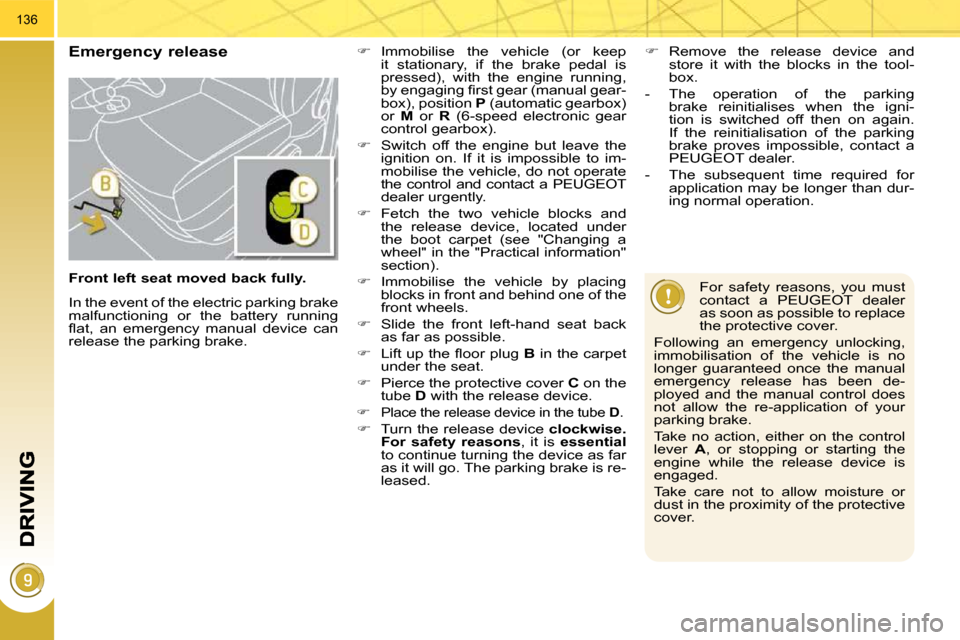
136
Front left seat moved back fully.
In the event of the electric parking brake
malfunctioning or the battery running
�fl� �a�t�,� �a�n� �e�m�e�r�g�e�n�c�y� �m�a�n�u�a�l� �d�e�v�i�c�e� �c�a�n�
release the parking brake.
Emergency release
� Immobilise the vehicle (or keep
it stationary, if the brake pedal is
pressed), with the engine running,
�b�y� �e�n�g�a�g�i�n�g� �fi� �r�s�t� �g�e�a�r� �(�m�a�n�u�a�l� �g�e�a�r�-
box), position P (automatic gearbox)
or M or R (6-speed electronic gear
control gearbox).
� Switch off the engine but leave the
ignition on. If it is impossible to im-
mobilise the vehicle, do not operate
the control and contact a PEUGEOT
dealer urgently.
� Fetch the two vehicle blocks and
the release device, located under
the boot carpet (see "Changing a
wheel" in the "Practical information"
section).
� Immobilise the vehicle by placing
blocks in front and behind one of the
front wheels.
� Slide the front left-hand seat back
as far as possible.
� � � �L�i�f�t� �u�p� �t�h�e� �fl� �o�o�r� �p�l�u�g� � B in the carpet
under the seat.
� Pierce the protective cover C on the
tube D with the release device.
� Place the release device in the tube D .
� Turn the release device clockwise.
For safety reasons , it is essential
to continue turning the device as far
as it will go. The parking brake is re-
leased.
� Remove the release device and
store it with the blocks in the tool-
box.
- The operation of the parking brake reinitialises when the igni-
tion is switched off then on again.
If the reinitialisation of the parking
brake proves impossible, contact a
PEUGEOT dealer.
- The subsequent time required for application may be longer than dur-
ing normal operation.
For safety reasons, you must
contact a PEUGEOT dealer
as soon as possible to replace
the protective cover.
Following an emergency unlocking,
immobilisation of the vehicle is no
longer guaranteed once the manual
emergency release has been de-
ployed and the manual control does
not allow the re-application of your
parking brake.
Take no action, either on the control
lever A , or stopping or starting the
engine while the release device is
engaged.
Take care not to allow moisture or
dust in the proximity of the protective
cover.
Page 163 of 324
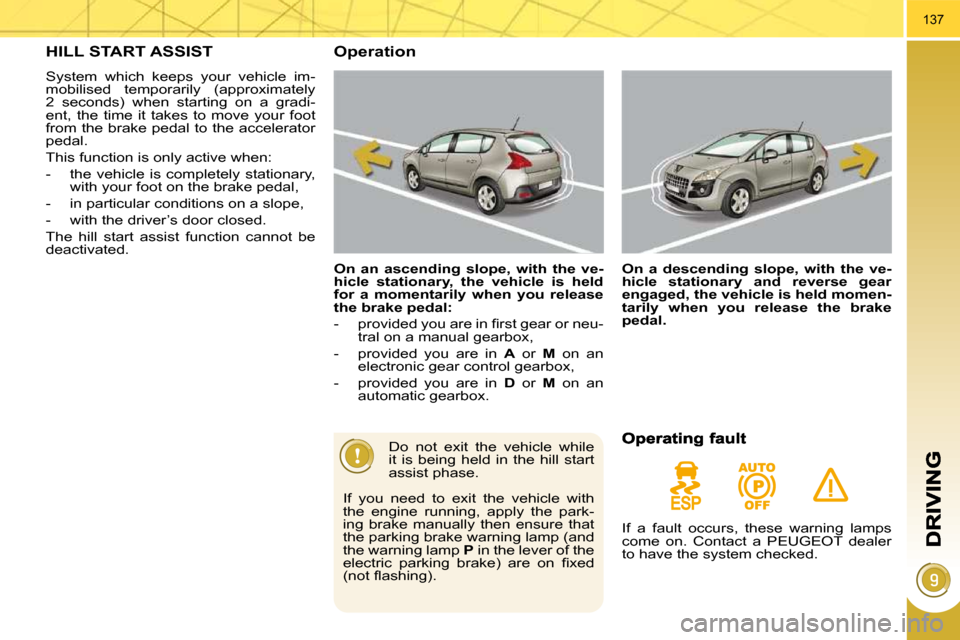
137
HILL START ASSIST
System which keeps your vehicle im-
mobilised temporarily (approximately
2 seconds) when starting on a gradi-
ent, the time it takes to move your foot
from the brake pedal to the accelerator
pedal.
This function is only active when:
- the vehicle is completely stationary, with your foot on the brake pedal,
- in particular conditions on a slope,
- with the driver’s door closed.
The hill start assist function cannot be
deactivated.
Operation
On an ascending slope, with the ve-
hicle stationary, the vehicle is held
for a momentarily when you release
the brake pedal:
� � � �-� � �p�r�o�v�i�d�e�d� �y�o�u� �a�r�e� �i�n� �fi� �r�s�t� �g�e�a�r� �o�r� �n�e�u�- tral on a manual gearbox,
- provided you are in A or M on an
electronic gear control gearbox,
- provided you are in D or M on an
automatic gearbox.
On a descending slope, with the ve-
hicle stationary and reverse gear
engaged, the vehicle is held momen-
tarily when you release the brake
pedal.
Do not exit the vehicle while
it is being held in the hill start
assist phase.
If you need to exit the vehicle with
the engine running, apply the park-
ing brake manually then ensure that
the parking brake warning lamp (and
the warning lamp P in the lever of the
�e�l�e�c�t�r�i�c� �p�a�r�k�i�n�g� �b�r�a�k�e�)� �a�r�e� �o�n� �fi� �x�e�d�
�(�n�o�t� �fl� �a�s�h�i�n�g�)�.� � �
If a fault occurs, these warning lamps
come on. Contact a PEUGEOT dealer
to have the system checked.
Page 164 of 324
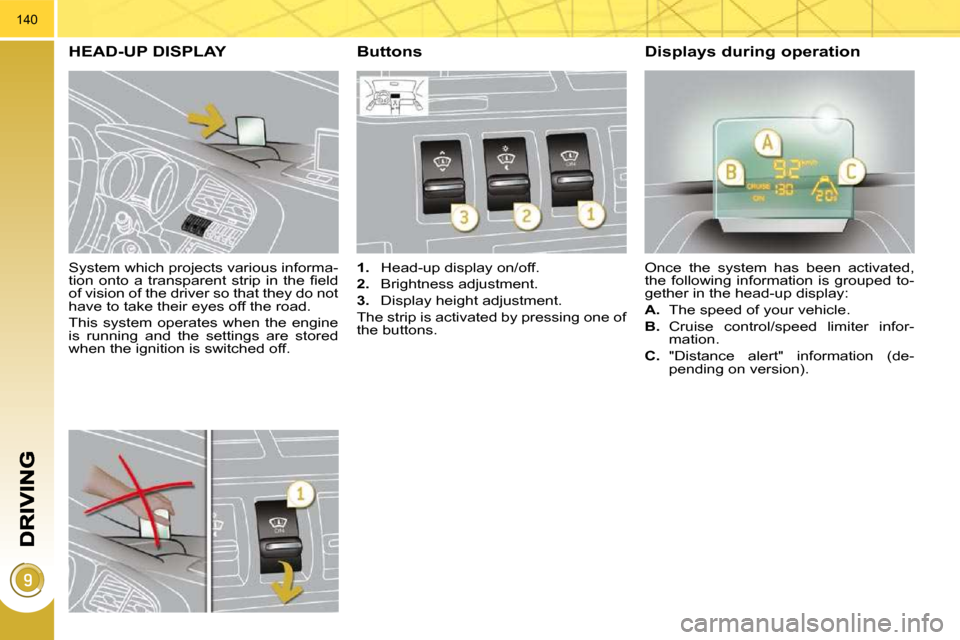
140
System which projects various informa-
�t�i�o�n� �o�n�t�o� �a� �t�r�a�n�s�p�a�r�e�n�t� �s�t�r�i�p� �i�n� �t�h�e� �fi� �e�l�d�
of vision of the driver so that they do not
have to take their eyes off the road.
This system operates when the engine
is running and the settings are stored
when the ignition is switched off.
HEAD-UP DISPLAY
1. Head-up display on/off.
2. Brightness adjustment.
3. Display height adjustment.
The strip is activated by pressing one of
the buttons. Once the system has been activated,
the following information is grouped to-
gether in the head-up display:
A. The speed of your vehicle.
B. Cruise control/speed limiter infor-
mation.
Buttons Displays during operation
C. "Distance alert" information (de-
pending on version).
Page 165 of 324
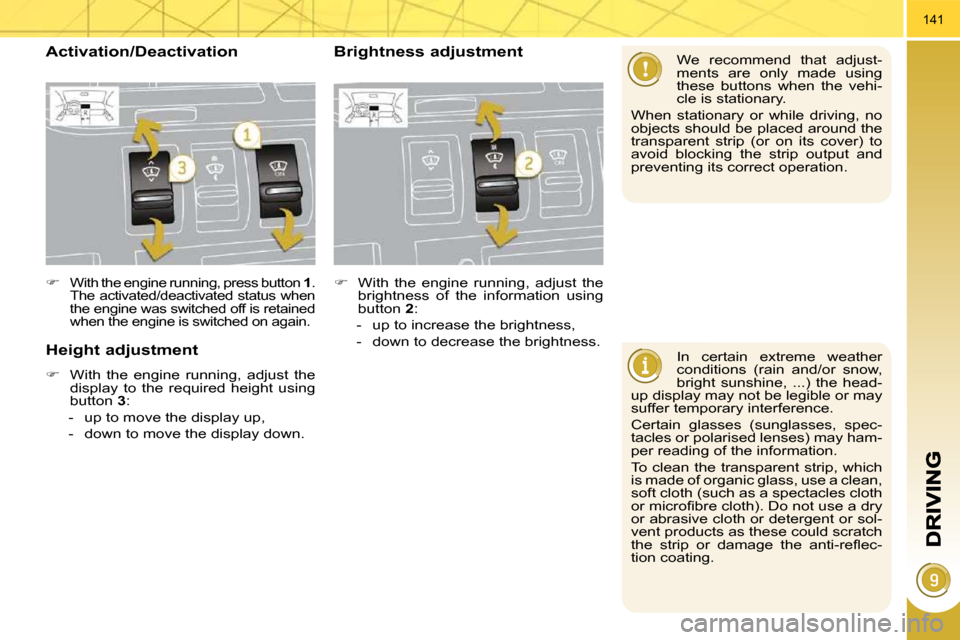
141
In certain extreme weather
conditions (rain and/or snow,
bright sunshine, ...) the head-
up display may not be legible or may
suffer temporary interference.
Certain glasses (sunglasses, spec-
tacles or polarised lenses) may ham-
per reading of the information.
To clean the transparent strip, which
is made of organic glass, use a clean,
soft cloth (such as a spectacles cloth
�o�r� �m�i�c�r�o�fi� �b�r�e� �c�l�o�t�h�)�.� �D�o� �n�o�t� �u�s�e� �a� �d�r�y�
or abrasive cloth or detergent or sol-
vent products as these could scratch
�t�h�e� �s�t�r�i�p� �o�r� �d�a�m�a�g�e� �t�h�e� �a�n�t�i�-�r�e�fl� �e�c�-
tion coating. We recommend that adjust-
ments are only made using
these buttons when the vehi-
cle is stationary.
When stationary or while driving, no
objects should be placed around the
transparent strip (or on its cover) to
avoid blocking the strip output and
preventing its correct operation.
� With the engine running, press button 1 .
The activated/deactivated status when
the engine was switched off is retained
when the engine is switched on again.
Height adjustment
� With the engine running, adjust the
display to the required height using
button 3 :
- up to move the display up,
- down to move the display down.
Activation/Deactivation Brightness adjustment
� With the engine running, adjust the
brightness of the information using
button 2 :
- up to increase the brightness,
- down to decrease the brightness.
Page 166 of 324
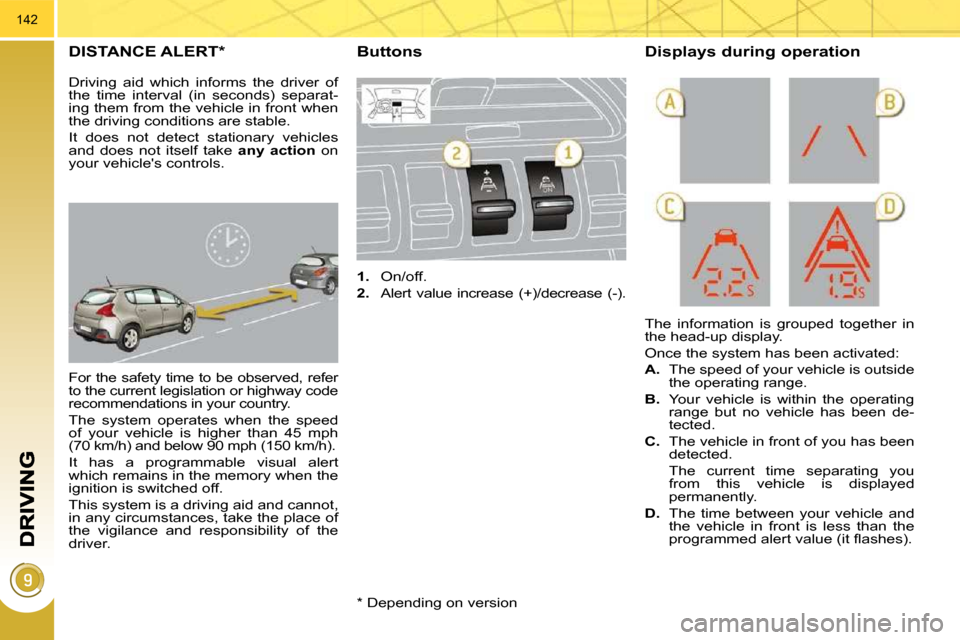
142
DISTANCE ALERT*
For the safety time to be observed, refer
to the current legislation or highway code
recommendations in your country.
The system operates when the speed
of your vehicle is higher than 45 mph
(70 km/h) and below 90 mph (150 km/h).
It has a programmable visual alert
which remains in the memory when the
ignition is switched off.
This system is a driving aid and cannot,
in any circumstances, take the place of
the vigilance and responsibility of the
driver.
1. On/off.
2. Alert value increase (+)/decrease (-).
The information is grouped together in
the head-up display.
Once the system has been activated:
A. The speed of your vehicle is outside
the operating range.
B. Your vehicle is within the operating
range but no vehicle has been de-
tected.
C. The vehicle in front of you has been
detected.
The current time separating you from this vehicle is displayed
permanently.
D. The time between your vehicle and
the vehicle in front is less than the
�p�r�o�g�r�a�m�m�e�d� �a�l�e�r�t� �v�a�l�u�e� �(�i�t� �fl� �a�s�h�e�s�)�.� � �
Buttons Displays during operation
Driving aid which informs the driver of
the time interval (in seconds) separat-
ing them from the vehicle in front when
the driving conditions are stable.
It does not detect stationary vehicles
and does not itself take any action on
your vehicle's controls.
* Depending on version
Page 167 of 324
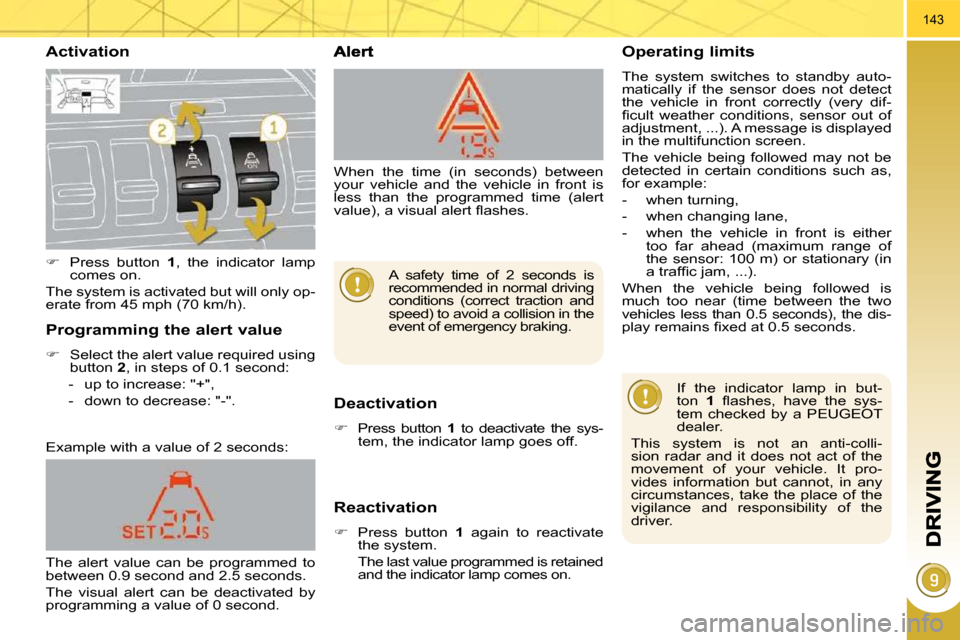
143
Activation
Deactivation
� Press button 1 to deactivate the sys-
tem, the indicator lamp goes off.
Reactivation
� Press button 1 again to reactivate
the system.
The last value programmed is retained and the indicator lamp comes on.
Example with a value of 2 seconds:
Operating limits
The system switches to standby auto-
matically if the sensor does not detect
the vehicle in front correctly (very dif-
�fi� �c�u�l�t� �w�e�a�t�h�e�r� �c�o�n�d�i�t�i�o�n�s�,� �s�e�n�s�o�r� �o�u�t� �o�f�
adjustment, ...). A message is displayed
in the multifunction screen.
The vehicle being followed may not be
detected in certain conditions such as,
for example:
- when turning,
- when changing lane,
- when the vehicle in front is either
too far ahead (maximum range of
the sensor: 100 m) or stationary (in
�a� �t�r�a�f�fi� �c� �j�a�m�,� �.�.�.�)�.� �
When the vehicle being followed is
much too near (time between the two
vehicles less than 0.5 seconds), the dis-
�p�l�a�y� �r�e�m�a�i�n�s� �fi� �x�e�d� �a�t� �0�.�5� �s�e�c�o�n�d�s�.�
Programming the alert value
� Select the alert value required using
button 2 , in steps of 0.1 second:
- up to increase: "+",
- down to decrease: "-". If the indicator lamp in but-
ton
1� � �fl� �a�s�h�e�s�,� �h�a�v�e� �t�h�e� �s�y�s�-
tem checked by a PEUGEOT
dealer.
This system is not an anti-colli-
sion radar and it does not act of the
movement of your vehicle. It pro-
vides information but cannot, in any
circumstances, take the place of the
vigilance and responsibility of the
driver.
� Press button 1 , the indicator lamp
comes on.
The system is activated but will only op-
erate from 45 mph (70 km/h).
The alert value can be programmed to
between 0.9 second and 2.5 seconds.
The visual alert can be deactivated by
programming a value of 0 second. When the time (in seconds) between
your vehicle and the vehicle in front is
less than the programmed time (alert
�v�a�l�u�e�)�,� �a� �v�i�s�u�a�l� �a�l�e�r�t� �fl� �a�s�h�e�s�.�
A safety time of 2 seconds is
recommended in normal driving
conditions (correct traction and
speed) to avoid a collision in the
event of emergency braking.
Page 168 of 324
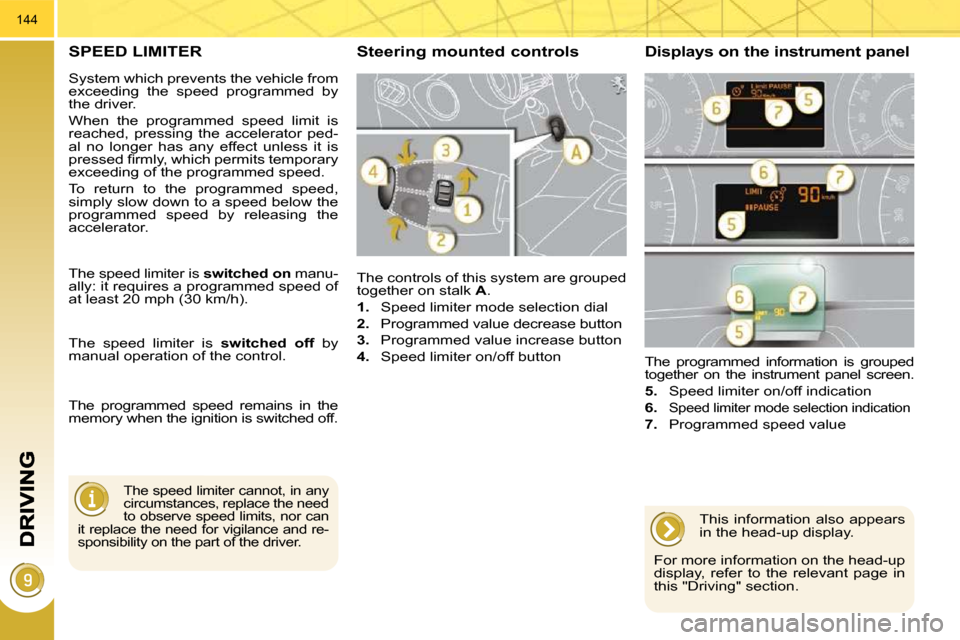
144
SPEED LIMITER
The controls of this system are grouped
together on stalk A .
1. Speed limiter mode selection dial
2. Programmed value decrease button
3. Programmed value increase button
4. Speed limiter on/off button
The programmed information is grouped
together on the instrument panel screen.
5. Speed limiter on/off indication
6.
Speed limiter mode selection indication
7. Programmed speed value
Steering mounted controls Displays on the instrument panel
The speed limiter cannot, in any
circumstances, replace the need
to observe speed limits, nor can
it replace the need for vigilance and re-
sponsibility on the part of the driver.
The speed limiter is switched on manu-
ally: it requires a programmed speed of
at least 20 mph (30 km/h).
The speed limiter is switched off by
manual operation of the control.
The programmed speed remains in the
memory when the ignition is switched off.
This information also appears
in the head-up display.
For more information on the head-up
display, refer to the relevant page in
this "Driving" section.
System which prevents the vehicle from
exceeding the speed programmed by
the driver.
When the programmed speed limit is
reached, pressing the accelerator ped-
al no longer has any effect unless it is
�p�r�e�s�s�e�d� �fi� �r�m�l�y�,� �w�h�i�c�h� �p�e�r�m�i�t�s� �t�e�m�p�o�r�a�r�y�
exceeding of the programmed speed.
To return to the programmed speed,
simply slow down to a speed below the
programmed speed by releasing the
accelerator.
Page 169 of 324
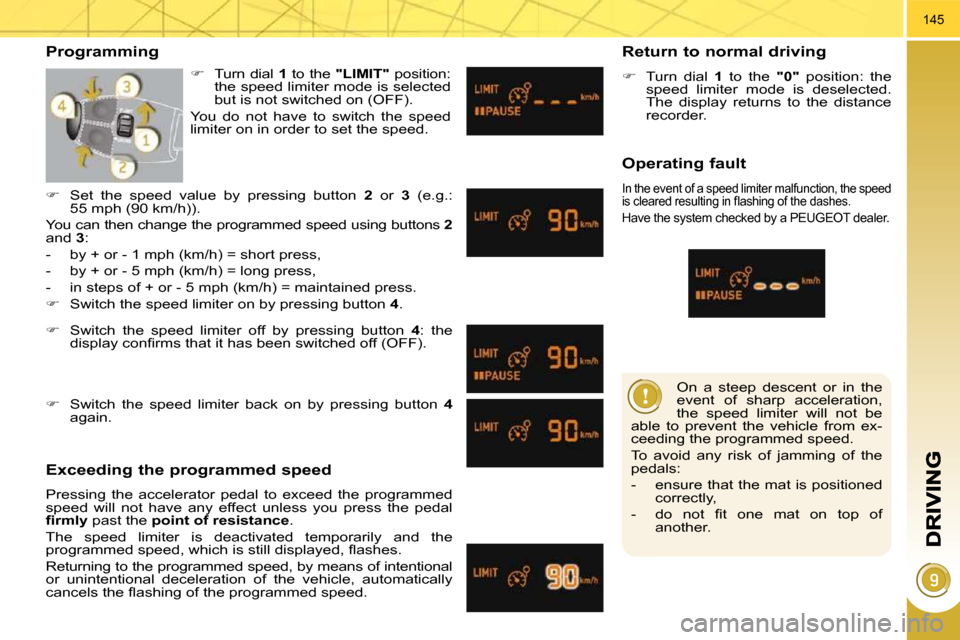
145
On a steep descent or in the
event of sharp acceleration,
the speed limiter will not be
able to prevent the vehicle from ex-
ceeding the programmed speed.
To avoid any risk of jamming of the
pedals:
- ensure that the mat is positioned correctly,
� � �-� � �d�o� �n�o�t� �fi� �t� �o�n�e� �m�a�t� �o�n� �t�o�p� �o�f� another.
Programming
Exceeding the programmed speed
Pressing the accelerator pedal to exceed the programmed
speed will not have any effect unless you press the pedal
�fi� �r�m�l�y past the point of resistance .
The speed limiter is deactivated temporarily and the
�p�r�o�g�r�a�m�m�e�d� �s�p�e�e�d�,� �w�h�i�c�h� �i�s� �s�t�i�l�l� �d�i�s�p�l�a�y�e�d�,� �fl� �a�s�h�e�s�.�
Returning to the programmed speed, by means of int entional
or unintentional deceleration of the vehicle, automaticall y
�c�a�n�c�e�l�s� �t�h�e� �fl� �a�s�h�i�n�g� �o�f� �t�h�e� �p�r�o�g�r�a�m�m�e�d� �s�p�e�e�d�.� �
Return to normal driving
� Turn dial 1 to the "0" position: the
speed limiter mode is deselected.
The display returns to the distance
recorder.
Operating fault
In the event of a speed limiter malfunction, the s peed
�i�s� �c�l�e�a�r�e�d� �r�e�s�u�l�t�i�n�g� �i�n� �fl� �a�s�h�i�n�g� �o�f� �t�h�e� �d�a�s�h�e�s�.�
Have the system checked by a PEUGEOT dealer.
� Switch the speed limiter off by pressing button 4 : the
�d�i�s�p�l�a�y� �c�o�n�fi� �r�m�s� �t�h�a�t� �i�t� �h�a�s� �b�e�e�n� �s�w�i�t�c�h�e�d� �o�f�f� �(�O�F�F�)�.�
� Switch the speed limiter back on by pressing button 4
again.
� Set the speed value by pressing button 2 or 3 (e.g.:
55 mph (90 km/h)).
You can then change the programmed speed using but tons 2
and 3 :
- by + or - 1 mph (km/h) = short press,
- by + or - 5 mph (km/h) = long press,
- in steps of + or - 5 mph (km/h) = maintained press.
� Switch the speed limiter on by pressing button 4 .
� Turn dial 1 to the "LIMIT" position:
the speed limiter mode is selected
but is not switched on (OFF).
You do not have to switch the speed
limiter on in order to set the speed.
Page 170 of 324
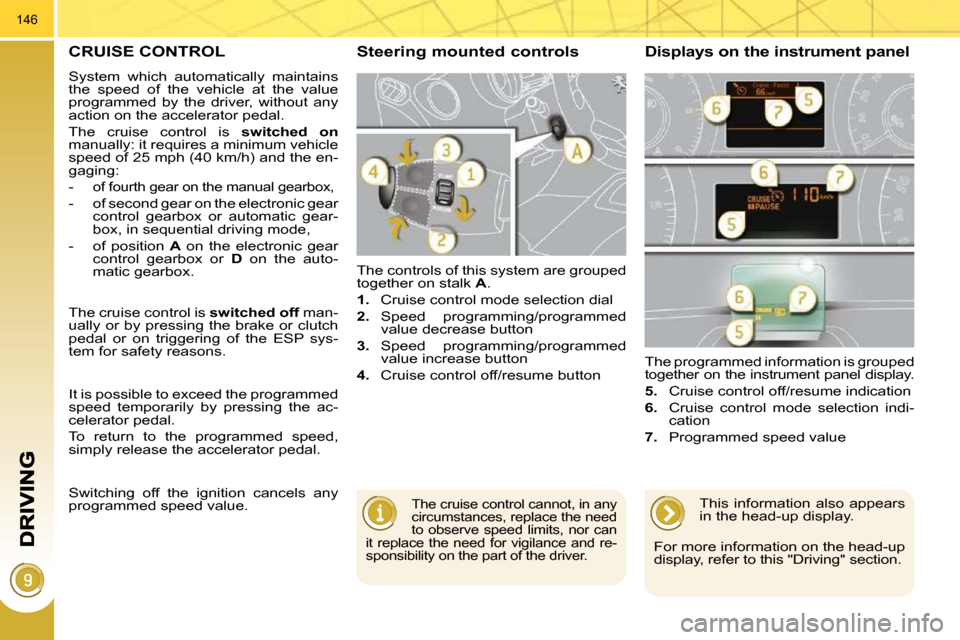
146
CRUISE CONTROL
System which automatically maintains
the speed of the vehicle at the value
programmed by the driver, without any
action on the accelerator pedal.
The cruise control is switched on
manually: it requires a minimum vehicle
speed of 25 mph (40 km/h) and the en-
gaging:
-
of fourth gear on the manual gearbox,
- of second gear on the electronic gear control gearbox or automatic gear-
box, in sequential driving mode,
- of position A on the electronic gear
control gearbox or D on the auto-
matic gearbox. The controls of this system are grouped
together on stalk
A .
1. Cruise control mode selection dial
2. Speed programming/programmed
value decrease button
3. Speed programming/programmed
value increase button
4. Cruise control off/resume button The programmed information is grouped
together on the instrument panel display.
5. Cruise control off/resume indication
6. Cruise control mode selection indi-
cation
7. Programmed speed value
Steering mounted controls Displays on the instrument panel
The cruise control cannot, in any
circumstances, replace the need
to observe speed limits, nor can
it replace the need for vigilance and re-
sponsibility on the part of the driver.
The cruise control is switched off man-
ually or by pressing the brake or clutch
pedal or on triggering of the ESP sys-
tem for safety reasons.
It is possible to exceed the programmed
speed temporarily by pressing the ac-
celerator pedal.
To return to the programmed speed,
simply release the accelerator pedal.
Switching off the ignition cancels any
programmed speed value. This information also appears
in the head-up display.
For more information on the head-up
display, refer to this "Driving" section.